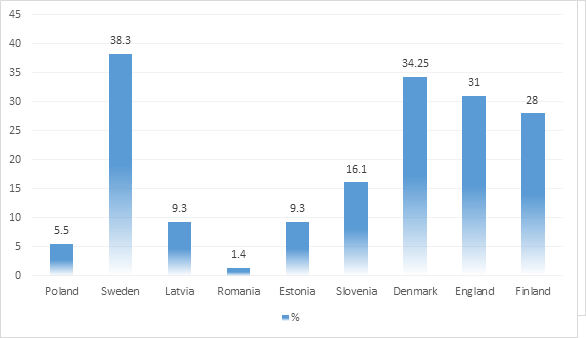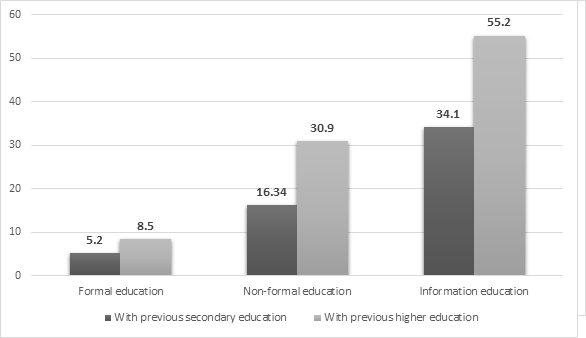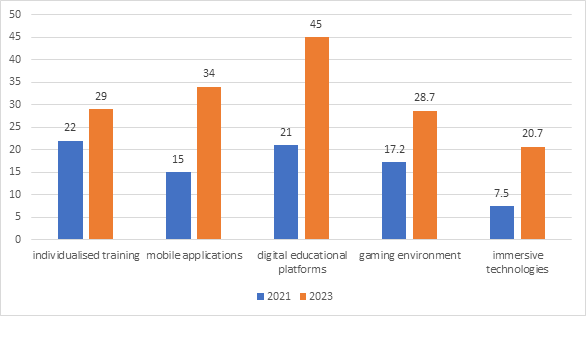
Informal education is a process of self-organised acquisition of specific competencies. Although not necessarily goal-oriented and structured, it actively contributes to expanding professional knowledge and skills and is positioned as one of the critical competencies of an individual. Informal education has gained particular significance in the era of internationalisation. The article aims to analyse the specifics of organising informal education for students in the field of life safety against the backdrop of global internationalisation, based on the experience of foreign countries. The research identifies the primary forms of informal education, including single lectures, video lessons, online consultations, and communication tools. It has been established that informal education creates preconditions for self-realisation, acquisition of new knowledge, skills, and competencies, increased motivation, and professional competence. Mechanisms for crediting the results of informal learning to formal education have been provided. It has been found that the educational environment in the era of internationalisation involves academic mobility, active international relations, projects, research initiatives, and academic programs, as well as the integration of international, intercultural, and global dimensions into higher education goals. Policies and programs appropriate to implement in response to globalisation as a tool for maximising its opportunities have been identified. An analysis of the national internationalisation of informal education in life safety, consideration of its organisational strategies through the prism of target programs and personal motivation of higher education students has been conducted. It has been proven that informal education in life safety enhancement is flexible, not limited by time frames, and does not involve certain procedural formalities. It aims to improve students’ life activities, allowing them to actively socialise and enhance their socio-economic status.
A high level of education among employees in any field of activity contributes to reducing the number of occupational diseases and accidents, including fatal ones. The leading cause of high levels of industrial injuries globally and in Ukraine is the human factor, specifically the failure of employers and employees to comply with life safety requirements due to the low effectiveness of sectoral education and the absence of compelling personal motivation. This problem is intensified by the destructive phenomenon of the devaluation of knowledge acquired by students in educational institutions even before graduation. This trend necessitates the integration of the concept of informal education into the modern higher education system, which fosters sustainable skills for continuous self-education among students. This strategy becomes particularly relevant in the context of the conceptual foundations for developing life safety competencies. Modern education on occupational safety should focus on the formal study of sectoral legislative and regulatory acts and on organising informal education for learners within the framework of the active internationalisation of the educational space. Research on the organisation and use of informal education and its impact on ensuring the safety of human resources in Ukraine is particularly relevant today.
Many researchers have focused on studying the aspects of the development of informal education as a foundation for the continuous self-improvement of specialists and the processes of internationalising the educational environment, including Boichuk [1], Kyrychenko [2], and Shevchenko [3]. The issues of informal education in the field of life safety have been explored in the scientific works of Yuldashev et al. [4], Shcherbak et al. [5], Kupina [6], and Kvashuk [7]. Sydorenko et al. [8] consider the formation of a model of informal education to be an essential direction for enhancing the effectiveness of the higher education system in the context of educational functions such as sociocultural, adaptive, economic, and general education. These functions of informal education, as an essential element of continuous education, should form the basis for motivating future specialists to preserve their own lives and health in the workplace and in everyday life. Similar opinions are held by Vovk et al. [9] and Drozd [10], who argue that informal education plays a significant role in improving industrial safety during students’ professional training and future professional activities. These scientists mainly focus on the fundamental issues of developing continuous informal education. At the same time, the application of its vector in internationalising the educational and professional environment needs to be addressed.
The study aims to analyse the specifics of organising information education for students in the field of life safety against the background of global internationalisation, based on the experience of foreign countries.
During the study, several general scientific methods were used, including:
analysis and synthesis to study current theoretical concepts and scientific developments on the issues of information education, clarify the terminology, and assess the impact of internationalisation on the educational process;
comparison to systematise conceptual approaches to the definition of basic concepts and criteria for choosing practical tools for information education in the context of globalisation to identify related risks and obstacles;
structural and logical methods to develop proposals for improving the organisational mechanism.
The educational factor is paramount in the current concept of human resource development. The main task of the member countries of the European community is to create educational systems that allow the recognition of the results of non-formal and informal learning. It is becoming evident that investments in education and professional training, the development of various competencies, and continuous professional development contribute to enhancing human capital quality, which is the foundation of effective socio-economic development.
Traditional educational technologies cannot effectively fulfil their intended functions in the context of the innovative transformation of social processes and the ever-increasing amount of information. Implementing a mechanism to motivate students towards systematic, continuous self-improvement of their competence in life safety is becoming increasingly relevant.
Developed foreign countries have long recognised that ensuring a specialist’s high productivity and competitiveness is only possible by implementing the concept of safe, professional activity. The conditions that facilitate personal and professional development intensify the relevance of implementing informal education. The personal aspect becomes important: behavioural reactions to specific events and the adequacy of actions in emergencies, formed under self-updated knowledge of occupational safety and life safety requirements, personal qualities, and intuition [11]. There are currently no statistical data on student involvement in the informal education system in Ukraine. Therefore, it seems helpful to analyse the proportion of students in individual European Community member countries involved in the informal education system (Figure 1).

Analysing Figure 1, it can be determined that the average level of student involvement in informal learning in Europe is about 10%, meaning one in ten education seekers, while in developed countries, it is one in three.
It is necessary to note that among all components of the continuous education system in the higher education environment, informal learning has a more significant correlation between the levels of prior education and the forms of its acquisition (Figure 2).

A representative correlation is seen between the level of prior education and the degree of involvement in various forms of education acquisition: the higher the level of prior education, the greater the potential ability to self-improve and self-learn.
Formal education does not fully allow for achieving the primary goal of modern education – to form an individual who can effectively realise their potential, be mobile, and adapt to the dynamic conditions of future professional activity [13]. Informal Education (IE) gives a person the opportunity to learn independently. Education is now positioned as a global process of continuous knowledge renewal, which is practically impossible to ensure without informal education, especially regarding life safety and labour protection.
The strategy of informal education in internationalisation optimally forms students’ life skills and healthy lifestyles, supplementing their professional competence deficit. In the process of interaction with formal and non-formal education, informal learning acquires innovative qualities. Considering educational trends and transformations in the modern labour market, it can gradually acquire the concept of non-formal education, which will enhance the efficiency of life safety and labour. Informal education can be implemented by integrating innovative teaching methods of modular, distance, and blended learning, which promotes creativity and motivates the individualisation of the educational process [14]. In particular, the following methods of informal learning can be successfully used in the process of life safety education:
The “trial and error” method, which motivates independent search for answers to problem questions;
Mutual learning in the process of jointly solving assigned tasks;
Forming a system of acquiring modern knowledge of labour protection using innovative information technologies and artificial intelligence;
Attracting global experience through visits to exhibitions, museums, and projects, including online;
Using innovative digital educational platforms, mobile applications, and online resources that promote the maximum implementation of the educational process in the worldview system of modern youth.
Remote knowledge testing, carried out to ensure the online student’s visual authentication, can be used to control the effectiveness of informal education.
An educational environment that is as close as possible to the actual conditions of future professional activity should be formed in higher education institutions with the involvement of immersive technologies. The latter are identified as integrating virtual content into the physical environment, creating conditions for effective interaction [15]. At the same time, the user perceives the virtual components as an integral part. The spectrum of immersive technologies covers a range of various programs and tools that allow integration, immersion, or interaction with simulated environments and objects [16].
Figure 3 reflects information on integrating innovative pedagogical technologies in informal education in European universities.

Given the necessity for the quality preparation of modern education seekers for life in a prospective digital society, the support of educational projects involving virtual reality technologies is being intensified. Recently, immersive technologies have gained popularity as management systems components, including life safety. The most popular immersive technologies include augmented reality (AR) and virtual reality (VR). These technologies create the prerequisites for effective interaction, modelling, and forecasting in a three-dimensional plane. At the same time, augmented reality is created using a regular smartphone, while virtual reality requires a helmet and glasses.
Considering the global trend of implementing immersive technologies into the management process in most spheres of public activity, it should be noted that the education sector is currently the leading investor in the development of the virtual technology industry. Shortly, virtual and augmented realities will be positioned as everyday phenomena, similar to mobile devices.
Immersive technologies are identified as integrating virtual content into the physical environment, creating conditions for effective interaction. In this context, the user perceives the virtual components as an integral part. The spectrum of immersive technologies covers a range of various programs and tools that allow integration, immersion, or interaction with simulated environments and objects.
Given the close interrelationship between formal, non-formal, and informal education systems, the latter allows for optimising the structure of the formal system by introducing innovative elements of non-formal learning, enabling the development of existing and the formation of new competencies of the education seeker. Informal education is based on independently monitoring changes in sectoral legislation, participating in seminars, online events, and conferences dedicated to current labour protection issues, and analysing experience while widely utilising the potential of social networks and information and communication technologies. In internationalisation, it seems necessary to research the requirements of European legislation in life safety. European integration processes will be prioritised during the post-war reconstruction of Ukraine, defining the professional requirements of the new era for specialists.
Researcher Leask [18] highlights specific prerequisites for functioning an effective paradigm of informal and non-formal education in life safety based on an integrated approach, emphasising the necessity of having an appropriate resource base and society’s readiness for dynamic changes. The results of modern scientific searches, in particular by Ismara et al. [19], and Shiradkar et al. [20], indicate that the integration of innovative educational methodologies in the concept of global internationalisation of society ensures a systematic and coordinated approach to managing human resource development.
Some scientists, particularly Seufert et al. [21], emphasise the need to transform the existing management system in higher education. Specifically, Papanastasiou et al. [22] confirm that one of the most effective means for enhancing the quality of education is the active use of modern virtual reality technology tools. Researchers such as Sanabria [23], Zhu et al. [24], Perey et al. [25] also point to the need to reveal the potential of interacting modern innovative solutions in education developed using virtual and mixed reality technologies. Considering Perey’s conclusions about preventive training and educational systems based on virtual reality technologies, the strategic opportunity for their use in informal education in life safety becomes evident.
According to Arifin et al. [26], augmented reality applications will be the priority and primary weight of user experience in virtual reality technology management. The author believes that modelling modern educational content with immersion in virtual reality intensifies safety awareness, as the immersive environment with a sense of real presence results in higher engagement and motivation and deeper cognitive processing of educational material. Educational virtual reality applications have significant possibilities that are unavailable when using traditional educational technologies.
Despite significant scientific achievements in integrating informal education technologies in a globalised society, the issue of their large-scale practical adaptation to Ukraine’s realities remains unresolved. Developing an innovative approach to the management paradigm in higher education within the concept of converging the most effective innovative technologies and tools appears promising.
The rapid innovative development of modern information society is closely linked to the adaptive renewal and intensive transformation of the higher education system. Informal learning and training technologies can become essential for life safety.
The study found that informal learning technologies rapidly evolve from innovation to a practically used range of tools. It has been established that their implementation into the paradigm of higher education is positioned as a promising necessity and a factor in intensifying the quality of education.
The main features of informal education in life safety are its flexibility, lack of time constraints, no requirement for issuing mandatory documents, and no procedural formalities. This allows the enhancement of student competence and motivates adherence to legislative and regulatory acts on labour protection.
Given the state of war in Ukraine, increasing awareness of behaviour in emergencies, fires, explosions, and accidents is of particular significance. The practical organisation of informal education for students of any professional field in life safety, implemented through continuous self-learning, will allow for acquiring the necessary skills for hazard identification, planning a system of measures to prevent them, and preventive protection.